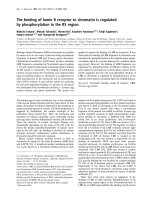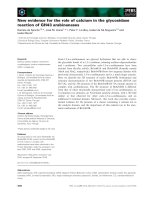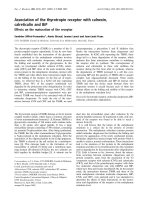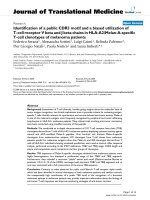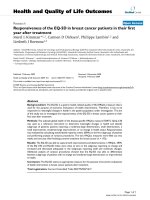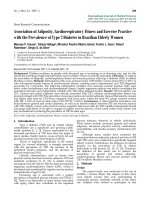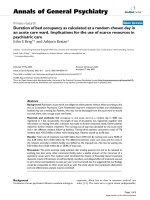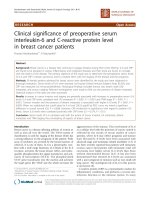Association of calcium sensing receptor polymorphisms at rs1801725 with circulating calcium in breast cancer patients
Bạn đang xem bản rút gọn của tài liệu. Xem và tải ngay bản đầy đủ của tài liệu tại đây (527.57 KB, 8 trang )
Wang et al. BMC Cancer (2017) 17:511
DOI 10.1186/s12885-017-3502-3
RESEARCH ARTICLE
Open Access
Association of calcium sensing receptor
polymorphisms at rs1801725 with
circulating calcium in breast cancer
patients
Li Wang2, Sarrah E. Widatalla1, Diva S. Whalen1, Josiah Ochieng1 and Amos M. Sakwe1*
Abstract
Background: Breast cancer (BC) patients with late-stage and/or rapidly growing tumors are prone to develop high
serum calcium levels which have been shown to be associated with larger and aggressive breast tumors in post
and premenopausal women respectively. Given the pivotal role of the calcium sensing receptor (CaSR) in calcium
homeostasis, we evaluated whether polymorphisms of the CASR gene at rs1801725 and rs1801726 SNPs in exon 7,
are associated with circulating calcium levels in African American and Caucasian control subjects and BC cases.
Methods: In this retrospective case-control study, we assessed the mean circulating calcium levels, the distribution
of two inactivating CaSR SNPs at rs1801725 and rs1801726 in 199 cases and 384 age-matched controls, and used
multivariable regression analysis to determine whether these SNPs are associated with circulating calcium in control
subjects and BC cases.
Results: We found that the mean circulating calcium levels in African American subjects were higher than those in
Caucasian subjects (p < 0.001). As expected, the mean calcium levels were higher in BC cases compared to control
subjects (p < 0.001), but the calcium levels in BC patients were independent of race. We also show that in BC cases
and control subjects, the major alleles at rs1801725 (G/T, A986S) and at rs1801726 (C/G, Q1011E) were common
among Caucasians and African Americans respectively. Compared to the wild type alleles, polymorphisms at the
rs1801725 SNP were associated with higher calcium levels (p = 0.006) while those at rs1801726 were not. Using
multivariable linear mixed-effects models and adjusting for age and race, we show that circulating calcium levels in
BC cases were associated with tumor grade (p = 0.009), clinical stage (p = 0.003) and more importantly, with
inactivating mutations of the CASR at the rs1801725 SNP (p = 0.038).
Conclusions: These data suggest that decreased sensitivity of the CaSR to calcium due to inactivating polymorphisms
at rs1801725, may predispose up to 20% of BC cases to high circulating calcium-associated larger and/or aggressive
breast tumors.
Keywords: Calcium-sensing receptor, Single nucleotide polymorphism, Cancer-induced hypercalcemia, Breast cancer,
Genome-wide association studies
* Correspondence:
1
Department of Biochemistry and Cancer Biology, School of Graduate
Studies and Research, Meharry Medical College, Nashville, TN 37208, USA
Full list of author information is available at the end of the article
© The Author(s). 2017 Open Access This article is distributed under the terms of the Creative Commons Attribution 4.0
International License ( which permits unrestricted use, distribution, and
reproduction in any medium, provided you give appropriate credit to the original author(s) and the source, provide a link to
the Creative Commons license, and indicate if changes were made. The Creative Commons Public Domain Dedication waiver
( applies to the data made available in this article, unless otherwise stated.
Wang et al. BMC Cancer (2017) 17:511
Background
Breast cancer (BC) is frequently diagnosed as an aggressive disease with poor prognosis especially in younger and
women of African ancestry. The underlying mechanisms
and factors that promote the aggressive behavior of BC in
this subset of patients remain poorly understood. Among
the potential factors is the development of cancer-induced
hypercalcemia (CIH), an often overlooked metabolic
disorder which is inevitable in late-stage, metastatic and
aggressive BC [1, 2]. Available evidence reveals that serum
calcium levels are elevated in women with untreated BC
[3], and that high serum calcium levels are associated with
aggressive breast tumors among premenopausal and/or
overweight women [4], and larger breast tumors among
postmenopausal women [5]. However, whether these high
calcium associated breast cancer outcomes are related to
the functional status of the calcium sensing receptor
(CaSR) [6] remains unclear.
As a major component of the calcium homoeostatic
system [7], the CaSR contributes to the development of
CIH by promoting the growth and metastatic properties
of tumor cells [8, 9] and/or by promoting the secretion
of tumor cell-derived osteolytic factors such as parathyroid hormone-related protein (PTHrP) [10–12]. However,, in bone and mineral ion disorders, the CaSR is
invariably mutated into several loss- or gain-of-function
variants [13, 14] and these are respectively associated
with hypercalcemia and hypocalcemia [15, 16]. The
CaSR proteins with loss-of-function or inactivating
mutations in the coding sequence have been shown to
be less sensitive to calcium [17, 18] and linked with
familial hypocalciuric hypercalcemia, more severe
primary hyperparathyroidism, and the risk of kidney
stones [13, 15, 19–21].
Among the several mutations in the cytosolic domain of
the CASR, single nucleotide polymorphisms (SNP) at
rs1801725 and rs1801726 in exon 7 are loss-of-function
or inactivating mutations. Polymorphisms at these SNPs
have not only been shown to lead to reduced sensitivity
(right-shifted response) to calcium [22] but are also important in the development of hypercalcemia in a mouse
model of squamous cell lung carcinoma [16]. Although
the CaSR is pivotal in calcium homeostasis, its contribution in the previously reported association of high calcium
with larger or more aggressive breast tumors remain unclear. In this study, we investigated whether these CASR
SNPs are associated with higher circulating calcium levels
in control versus BC Caucasian and African American
women. Our data reveal that CASR polymorphisms at
rs1801725 but not at rs1801726 SNP are associated with
calcium and suggest that polymorphisms at rs1801725 in
about 20% of BC cases, underlie, at least in part, the previously reported association of high circulating calcium with
BC progression into larger and/or aggressive tumors.
Page 2 of 8
Methods
Ethical considerations and study subjects
This study was classified by the Meharry Medical College
and Vanderbilt University institutional review boards as
non-human subject research and required a satisfactorily
completed Data Use Agreement for the Vanderbilt
University DNA biorepository (BioVU) and de-identified
patient records (Synthetic Derivative) databases. BC cases
were identified from these databases using the following
search criteria: ICD-9 code 174 (neoplasms of the female
breast), tumor registries, calcium assay data, gender (=
female), race (= Caucasian or African American) and
genome-wide association studies (GWAS) genotyping
data. For GWAS we focused on polymorphisms at codons
986 (rs1801725) and 1011 (rs1801726) in exon 7 (cytosolic
domain) of the CASR as these correspond to inactivating
mutant CaSRs with decreased sensitivity to calcium. Deidentified information about the disease grade and/or
stage was obtained from tumor registries while calcium
assay data were extracted from the Synthetic Derivative
database. For age-matched control records, only records
with calcium and GWAS data with no evidence of any
form of malignancy were retained for the study.
Statistical analysis
Descriptive statistics are presented as the median with
interquartile range (IQR) and mean +/− SD for calcium
assay data; and frequencies (percentages) for genotypes
and allele frequencies. The distribution of CASR genotypes and alleles frequency in the groups (control versus
BC cases or Caucasian versus African American) was
compared using Pearson Chi-squared test. The primary
outcome was circulating or serum calcium levels. The
average calcium levels as well as the genotypes at the
two SNPs between controls and BC cases or African
Americans (Blacks) and Caucasians (Whites) were compared using Wilcoxon rank sum test. The interaction
between calcium levels and genotypes at the two SNPs
was analyzed using the linear mixed-effects model
(additive and co-dominant) fit by restricted maximum
likelihood (REML) and adjusting for BC stage, grade,
race, and age at diagnosis. The Fisher’s exact test was
used to test the relationship between polymorphisms at
the two SNPs and BC stage and grade. All analyses
were performed using the statistical software R version
3.1.2 ( and a p < 0.05 was
considered to be statistically significant. To estimate
the power of our analysis especially for the continuous
variable calcium, we assumed that the standard deviation was 0.5 and a Type I error probability of 5%.
Using these parameters, we required 199 cases and 199
controls to detect a difference of 0.163 in calcium levels
between two groups with a 90% power.
Wang et al. BMC Cancer (2017) 17:511
Page 3 of 8
Results
BioVU search strategy, inclusion criteria and data
extraction
The BioVU and Synthetic Derivative databases at Vanderbilt
University have been successfully used to characterize genedisease associations in multiple diseases [23], to identify
predictors of diseases [24, 25] and to predict the risk of
disease [26, 27]. Based on an initial search for records with
calcium assay data, these databases contained 2111 records
from African Americans and 2996 records from Caucasians.
Our search criteria led to the identification of 359 BC cases
with calcium assay data of which 199 were linked to
genotyping data. This represented 58 records (29%) from
African American and 141 records (71%) from Caucasian
BC patients with a mean age of 54.9 ± 4.4 years. The BC
cases comprised BC patients with varying degrees of disease severity. As expected most of the cases were patients
with grades 2 and 3 or clinical stages I and II. Applying
our exclusion criteria to search these databases, we identified 384 records as age and genetic ancestry-matched
controls with calcium assay and genotyping data. This
included 113 (29%) and 271 (71%) records from African
American and Caucasian subjects respectively, with a
mean age of 56.1 ± 3.2 years.
Frequency of CaSR alleles in breast cancer cases
Analysis of the frequency of CASR alleles in the entire
dataset (Table 1) revealed that the majority of these
women (n = 583) expressed the wild type CASR at the
rs1801725 SNP (79%) and at the rs1801726 SNP (87%).
Table 1 also shows that the distribution of the major alleles at these loci was similar in the control subjects and
in BC cases. As such, the frequency of the A986S (G/T)
variant at the rs1801725 SNP was 19% in control versus
21% in BC cases, while the frequency of the Q1011E (C/
G) variant at the rs1801726 SNP was 13% versus 10% in
the control subjects and BC cases respectively. Overall,
the A986S (G/T) variant was more common (20%) than
the Q1011E (C/G) variant of the receptor (12%). Stratification of the distribution of the CASR variants by race
revealed that the A986S CASR variant was common
among Caucasians compared to African Americans (24%
versus 9%) while the Q1011E CASR variant was common among African American subjects compared to
Caucasians (24% versus 7%). All other alleles at the two
SNPs were infrequent among both control or BC cases
and the two racial groups.
Circulating calcium levels in control versus breast cancer
cases
For each study subject or identified record, multiple calcium measurements were obtained from distinct clinic
visits. The recorded calcium levels varied within a narrow
range for each control subject or BC case with some outliers (Fig. 1a). The BC cases comprised BC patients with
varying degrees of disease severity. As expected most of
the cases were patients with grades 2 and 3 (Fig. 1b) or
clinical stages I and II Fig. 1c). It should be noted that
diagnosis of most of the BC patients was indicated long
before the establishment of BioVU and Synthetic Derivative databases. For these reasons, the mean serum calcium
levels or the median and the 25th and 75th percentiles for
each subject were used for our analysis. As depicted in
Table 2 and as expected, the mean circulating calcium
level in BC cases was significantly higher than that in control subjects (P < 0.001). Table 2 also shows that among
Table 1 Distribution of rs1801725 and rs1801726 CaSR alleles in control subjects versus breast cancer cases
SNP ID
Genotype
Mutant
CaSR
n
%
n
%
n
%
RS1801725
G/G
A986A
304
79%
154
77%
458
79%
G/T
A986S
74
19%
41
21%
115
20%
RS1801726
Controls
n = 384
Breast cancer
cases n = 199
T/T
S986S
6
2%
4
2%
10
2%
C/C
Q1011Q
328
85%
178
89%
506
87%
C/G
Q1011E
50
13%
19
10%
69
12%
G/G
E1011E
6
2%
2
1%
8
1%
Blacks
N = 171
RS1801725
RS1801726
All samples
n = 583
Whites
N = 412
All samples
N = 583
G/G
A986A
154
90%
304
74%
458
79%
G/T
A986S
16
9%
99
24%
115
20%
T/T
S986S
1
1%
9
2%
10
2%
C/C
Q1011Q
121
71%
385
93%
506
87%
C/G
Q1011E
42
24%
27
7%
69
12%
G/G
E1011E
8
5%
0
0%
8
1%
Wang et al. BMC Cancer (2017) 17:511
Page 4 of 8
Fig. 1 Serum calcium values and distribution of breast cancer cases by disease severity. a Representative box plots of the multiple serum calcium
values from control and breast cancer cases. Each box plot represents the median and the Range (lower or 25th percentile and upper or 75th
percentile) of the multiple circulating calcium concentrations from a single control subject (green) or a single breast cancer case (red). b and c
Distribution of breast cancer cases according to tumor grades (b) and clinical stage (c)
the control subjects, the mean circulating calcium levels
were significantly higher in African American subjects
than in Caucasian subjects (n = 384; p < 0.001). However,
among the BC cases, the mean circulating calcium levels
were not significantly different between Caucasian and
African American cases (n = 199; p = 0.51). This suggests
that cancer-induced hypercalcemia is not associated
with race.
Inactivating CaSR mutants and circulating calcium levels
in breast cancer cases
To determine whether the two inactivating CaSR SNPs
are associated with calcium, we first compared the mean
circulating calcium levels in control subjects and BC
cases, stratified according to the CASR genotypes at the
two SNPs. As shown in Table 3, the mean circulating
calcium levels were significantly higher in all subjects
expressing the G/T (n = 115; p = 0.006) and T/T
(n = 10; p = 0.024) variants of the CASR at the
rs1801725 SNP compared to subjects expressing the wild
type receptor. Surprisingly, variants of the receptor at
the rs1801726 SNP were not associated with higher
serum calcium levels.
We next determined whether the genotypes of the
CASR at the two SNPs influenced circulating calcium
levels differently in Caucasian and African American
women expressing the major alleles at the two SNPs.
Table 4 shows that even though the mean circulating
calcium levels were higher in African American than in
Caucasian control subjects, the higher calcium levels in
African American women were not associated with the
expression of mutant CaSRs at the two SNPs. On the
other hand, serum calcium levels in control (p = 0.002)
and BC (p = 0.034) Caucasian women expressing the G/
Table 2 Circulating calcium levels in control subjects and breast cancer cases expressing inactivating CaSR mutants
Disease
Status
Control subjects
Race
African Americans
Breast cancer cases
a
b
n
Median Calcium
Range
n
Median calcium
Range
p-Valuec
384
9.09 ± 0.54
8.76–9.45
199
9.29 ± 0.40
9.02–9.52
<0.001
Caucasians
All Samples
171
9.28 ± 0.45
9.02–9.54
412
9.11 ± 0.55
8.80–9.46
<0.001
CONTROL
113
9.26 ± 0.47
9.00–9.53
271
9.02 ± 0.55
8.67–9.37
<0.001
BC Cases
58
9.30 ± 0.39
9.03–9.60
141
9.29 ± 0.40
9.02–9.50
0.51
a
mean circulating calcium ±1SD from multiple measurements over variable time periods. bthe lower and upper quartiles of circulating calcium levels for each
group. cSignificance of the difference in circulating calcium between controls and breast cancer cases or between African American and Caucasian control
subjects or BC cases. The p-values were calculated using the Wilcoxon rank sum test from the median with interquartile ranges for each group
Wang et al. BMC Cancer (2017) 17:511
Page 5 of 8
Table 3 Circulating calcium levels in control subjects and breast
cancer cases expressing inactivating CaSR mutants
SNP ID
Genotype
n
Meana
Rangeb
RS1801725
G/G (AA)
458
9.13 ± 0.51
8.83–9.46
G/T (AS)
115
9.25 ± 0.48
9.00–9.56
0.006
T/T (SS)
10
9.48 ± 0.50
9.29–9.75
0.024
C/C (QQ)
506
9.15 ± 0.52
8.86–9.48
C/G (QE)
69
9.20 ± 0.41
8.92–9.47
0.51
G/G (EE)
8
9.10 ± 0.69
9.07–9.50
0.75
RS1801726
aggressive breast tumors [3–5] in the up to 20% of
women with mutations at the rs1801725 SNP.
p-valuec
a
Mean circulating calcium (mg/dL) from multiple measurements over variable
time periods. bThe lowest and highest mean circulating calcium levels for each
genotype. cSignificance in the difference in circulating calcium in subjects
expressing the wild type receptor to those expressing polymorphic variants at
the two SNPs. The p-values were calculated using the Wilcoxon rank sum test
from the median with interquartile ranges for each genotype
T allele at the rs1801725 SNP were significantly higher
than those in Caucasian subjects expressing the wild
type receptor.
Association of calcium levels with CaSR variants and
breast cancer outcomes
The interaction between the two SNPs and circulating
calcium levels in BC cases was further evaluated using
the multivariable co-dominant and additive linear
mixed-effects models. Table 5 shows that after adjusting
for age and race, and as expected, circulating calcium
levels in BC cases were associated with tumor grade
(p = 0.009) and clinical stage (p = 0.003). More importantly, and consistent with data in Table 4, inactivating
mutations of the CASR at the rs1801725 SNP were significantly associated with circulating calcium (p = 0.038)
while inactivating mutations at the rs1801726 SNP were
not associated with circulating calcium (p = 0.942). Together with data in Table 1, these data suggest that polymorphic CASR variants at the rs1801725 SNP
contribute to the development of breast cancer-induced
hypercalcemia and consequently, the high circulating
calcium associated progression of BC into larger or
Discussion
Cancer-induced hypercalcemia (CIH) is a metabolic
syndrome which inevitably develops in patients with latestage BC and/or metastasis to skeletal tissues [11, 28, 29].
On the other hand, in most patients with low grade
tumors, CIH is either undetected or diagnosed as mild,
non-life threatening increase in circulating calcium.
Nevertheless, such mild increases in circulating calcium
levels may substantially promote disease progression by
activating the CaSR and/or other calcium dependent oncogenic pathways. Our findings that only polymorphisms in
the rs1801725 SNP of the receptor are associated with
higher calcium levels suggest that mutations in codon 986
in exon 7 of the CASR are associated with BC outcomes
driven by higher than normal circulating calcium levels
such as larger and more aggressive breast tumors.
High calcium mediated activation of the CaSR not
only leads to increased proliferation and migration of
BC cells [8] but also increased secretion of tumor cellderived PTHrP [8, 9] which contributes to the vicious
osteolytic cycle [28, 30]). Alteration of the function of
the CaSR by pharmacological inhibition of its activity
e.g. using calcilytic agents has been shown to inhibit
cancer cell proliferation and metastasis [31]. Although
decreased sensitivity of the receptor may be associated
with reduced activity at physiologically normal calcium
levels, inactivating mutant CaSRs require higher circulating calcium levels to effectively activate downstream
effectors. It is possible that a combination of inactivating
mutant CaSR expression and progressive increase in circulating cancer cell-derived osteolytic factors contribute
to the observed higher circulating calcium in BC cases.
Analysis of the distribution of the common CaSR alleles
at rs1801725 and rs1801726 SNPs among BC cases confirmed previous reports that the A986S CaSR variant is
common among Caucasians while the Q1011E variant is
Table 4 Circulating calcium levels in control subjects and breast cancer cases expressing inactivating CaSR mutants stratified by race
Control subjects
Breast cancer cases
SNP
Race
Genotype
n
Calcium (mg/dl)
rs1801725
Whites
G/G
203
8.96 ± 0.55
Blacks
rs1801726
G/T
63
9.16 ± 0.51
G/G
101
9.26 ± 0.48
G/T
11
9.25 ± 0.39
Whites
C/C
253
9.02 ± 0.56
C/G
18
9.06 ± 0.51
Blacks
C/C
75
9.31 ± 0.48
C/G
32
9.21 ± 0.36
p-valuea
0.002
0.83
0.69
0.21
n
Calcium (mg/dl)
101
9.24 ± 0.39
36
9.40 ± 0.43
53
9.30 ± 0.39
5
9.26 ± 0.42
132
9.29 ± 0.41
9
9.29 ± 0.36
46
9.29 ± 0.40
10
9.33 ± 0.39
p-valueb
0.034
0.82
0.95
0.95
Difference in the mean circulating calcium between subjects expressing the wild type and the mutant receptor in control (a) or breast cancer cases (b). The pvalues were calculated using the Wilcoxon rank sum test from the median with interquartile ranges for each group
Wang et al. BMC Cancer (2017) 17:511
Page 6 of 8
Table 5 Interaction between race, tumor grade, clinical stage
and CaSR SNPs with circulating calcium levels in breast cancer
patients
Parameter
Additive model
Co-dominant model
F-value
F-value
P-value
P-value
AGE AT DIAGNOSIS
0.27
0.6045
0.28
0.5981
RACE
0.40
0.5281
0.39
0.5318
BC GRADE
3.40
0.0088
3.38
0.0091a
TNM CLINICAL STAGE
4.02
0.0029
3.99
0.0031a
RS1801725
6.70
0.0104
3.33
0.0379a
RS1801726
0.80
0.7716
0.06
0.9420
a
Statistically significant association between parameter and circulating calcium
common among African Americans [17, 32–36]. Therefore, in both the control and BC cohorts, polymorphic
variants in exon 7 of the CaSR occur with distinct
frequencies among African Americans and Caucasians
but the implication, if any, of the CaSR variants in the
prognosis of BC patients requires further investigation.
Disparities in BC outcomes between Caucasian and
African American patients [37–40] as well as the involvement of the CaSR in cancer progression [41, 42]
have been amply reported. As expected and reported
previously, [17, 32–36], the magnitude of the differences
in circulating calcium observed in this study were modest. Our observation that circulating calcium levels in
BC cases were higher than those in control subjects is
consistent with the potential increase in the synthesis
and release of PTHrP by BC cells and the effects of this
PTH-like factor on bone resorption [29]. Meanwhile,
our finding that circulating calcium levels in African
American control subjects are higher than those in Caucasians is intriguing but supports the possibility that the
aggressive nature of breast carcinoma in some African
American patients may be driven at least in part, by high
circulating calcium-dependent mechanisms. Surprisingly,
the higher calcium levels in African American patients
does not seem to be due to the expression of inactivating
CaSR variants at the rs1801726 SNP which is more common in these subjects. One possible explanation for the
lack of association between circulating calcium and polymorphisms at the CASR 1801726 SNP may be the generally reported smaller numbers of African American
cases in the BioVU and other databases [43]. Overall,
this suggests that the high circulating calcium levels in
African Americans may be due to other factors that alter
systemic calcium homeostasis including the release of
calcium stimulated osteolytic factors by normal and/or
malignant breast tissues [29], and active vitamin D. Unfortunately, PTH and PTHrP were not part of routine
clinical tests and only a subset of patient serum chemistries included active vitamin D analysis from the control
and BC case cohorts with genotyping data. Therefore,
the confounding effects of PTHrP [10] or Vitamin D
[44] as cancer promoting calciotropic hormones could
not be evaluated.
It is well established that the CaSR is invariably mutated especially in parathyroid diseases [13, 14]. Our
study focused on rs1801725 and rs1801726 which are
well characterized inactivating mutations of the receptor
in exon 7 [34, 35, 45] to either support their association
with CIH or high calcium as an underlying factor for
the obvious disparities in the progression of BC in
Caucasians and African American patients. Interestingly, other SNPs e.g. rs1751221 [46] and rs112594756
[47] have been shown to correlate with BC susceptibility and prognosis. Although these intronic polymorphisms may affect the expression levels of the receptor,
it is unlikely that they are relevant in the overall sensitivity of the mature receptor to calcium and/or the
association of the receptor with CIH. Hypercalcemia in
patients with advanced and/or metastatic disease has
been reported to be strongly associated with poor prognosis [48] while inactivating mutations of the CaSR in
exon 7 promoted the development of hypercalcemia in
a xenograft mouse model of human squamous cell lung
carcinoma [16]. Although the level of serum calcium in
low grade BC patients may not be a prognostic indicator for survival, it is possible that the development of
hypercalcemia in 10–30% of BC patients without
evidence of skeletal metastases [49, 50] may at least in
part be due to the expression of inactivating CaSR
mutations especially at the rs1801725. Contrary to
previous studies showing that both the A986S and
Q1011E variants of the CaSR are associated with calcium
[34, 35], our findings suggest that polymorphisms at the
rs1801725 SNP are more important than those at the
rs1801726 SNP in the development of CIH and the associated BC outcomes.
Limitations of the study and conclusions
The objective of this study was to determine if differences in circulating calcium and the expression of inactivating CaSR mutants in BC patients could shed more
light on the causes of the highly aggressive disease in
African American patients. Unfortunately, the fewer
African American BC cases with both calcium test and
GWAS data in the BioVU databases led to inconclusive
interpretation of the relationship between circulating
calcium and polymorphisms at the rs1801726 SNP. Vitamin D (1,25-dihydroxy vitamin D) levels were not available for most of the cases and control subjects and
therefore, could not be considered as a confounding
variable. Also, the documented lab calcium tests used in
this study were total calcium rather than ionized calcium, the actual ligand for the CaSR. Consequently, it
was not possible to relate the potential CaSR activity to
Wang et al. BMC Cancer (2017) 17:511
the prevailing ionized calcium levels especially in BC
patients. Another interesting question which could not be
addressed in this study is the effect of these SNPs on
calcium levels in BC patients with. This will require a larger, multi-site study to establish not only a better understanding of the role of high circulating ionized calcium
but also the impact of inactivating CaSR mutants in BC
cases with poor prognosis versus those with favorable
prognosis. Overall, this retrospective case-control study
reveals that decreased sensitivity of the CaSR to calcium
due to inactivating polymorphisms at rs1801725 may
predispose BC patients to high circulating calcium-driven
larger or aggressive breast tumors.
Acknowledgments
We thank Dr. Ann Richmond, Department of Cancer Biology, Vanderbilt
Ingram Cancer Center for facilitating this study and critical reading of the
manuscript; Pengcheng Lu and Dr. Fei Fe, Vanderbilt Center for Quantitative
Sciences, Department of Biostatistics, for statistical analysis; Jennifer Madison,
Erica A. Bowton, Sarah P. Collier, and Jana Shirey-Rice, Vanderbilt CTSA for
help with the extraction of the datasets; and the Clinical Research Education
and Career Development (CRECD) Program at MMC for support to AMS.
Funding
This work was supported by the NIH/NIMHD 8 U54 MD007593 (Meharry
Translational Research Center through a Pilot project to AMS), NIH/NIGMS
5SC2CA170244 (AMS) and NIH/NIGMS 1SC1CA211030 (AMS). The datasets
used in the analyses described in this manuscript were obtained from the
Synthetic Derivative and BioVU databases supported by the Vanderbilt CTSA
grant ULTR000445 from NIH/NCATS.
Availability of data and materials
The datasets generated and used in this study are available from the
corresponding author on reasonable request.
Authors’ contributions
The study was conceived and designed by AMS; WL performed the statistical
analyses; AMS, SEW, DSW and JO contributed to the design, interpretation of
data and manuscript preparation. All authors have read and approved the
manuscript.
Ethics approval and consent to participate
This study was classified and approved by the Meharry Medical College and
Vanderbilt University Institutional Review Boards (IRBs) as non-human subject
research. The Vanderbilt University DNA biorepository (BioVU) and deidentified patient records (Synthetic Derivative) databases were used to generate the datasets subject to a satisfactorily completed Data Use Agreement.
Consent for publication
Not applicable.
Competing interests
The authors declare that they have no competing interests.
Publisher’s Note
Springer Nature remains neutral with regard to jurisdictional claims in
published maps and institutional affiliations.
Author details
1
Department of Biochemistry and Cancer Biology, School of Graduate
Studies and Research, Meharry Medical College, Nashville, TN 37208, USA.
2
Vanderbilt Center for Quantitative Sciences, Department of Biostatistics,
Vanderbilt University, Nashville, TN, USA.
Page 7 of 8
Received: 21 June 2017 Accepted: 24 July 2017
References
1. Santarpia L, Koch CA, Sarlis NJ. Hypercalcemia in cancer patients:
pathobiology and management. Horm Metab Res. 2010;42(3):153–64.
2. Soyfoo MS, Brenner K, Paesmans M, Body JJ. Non-malignant causes of
hypercalcemia in cancer patients: a frequent and neglected occurrence.
Support Care Cancer. 2013;21(5):1415–9.
3. Martin E, Miller M, Krebsbach L, Beal JR, Schwartz GG, Sahmoun AE. Serum
calcium levels are elevated among women with untreated postmenopausal
breast cancer. Cancer Causes Control. 2010;21(2):251–7.
4. Almquist M, Anagnostaki L, Bondeson L, Bondeson AG, Borgquist S,
Landberg G, Malina J, Malm J, Manjer J. Serum calcium and tumour
aggressiveness in breast cancer: a prospective study of 7847 women. Eur J
Cancer Prev. 2009;18(5):354–60.
5. Thaw SS, Sahmoun A, Schwartz GG. Serum calcium, tumor size, and
hormone receptor status in women with untreated breast cancer. Cancer
Biol Ther. 2012;13(7):467–71.
6. Brown EM, Gamba G, Riccardi D, Lombardi M, Butters R, Kifor O, Sun A,
Hediger MA, Lytton J, Hebert SC. Cloning and characterization of an
extracellular Ca(2+)-sensing receptor from bovine parathyroid. Nature. 1993;
366(6455):575–80.
7. Berridge MJ, Lipp P, Bootman MD. The versatility and universality of calcium
signalling. Nat Rev Mol Cell Biol. 2000;1(1):11–21.
8. Saidak Z, Boudot C, Abdoune R, Petit L, Brazier M, Mentaverri R, Kamel S.
Extracellular calcium promotes the migration of breast cancer cells through
the activation of the calcium sensing receptor. Exp Cell Res. 2009;315(12):
2072–80.
9. Sanders JL, Chattopadhyay N, Kifor O, Yamaguchi T, Brown EM. Ca(2
+)-sensing receptor expression and PTHrP secretion in PC-3 human prostate
cancer cells. Am J Physiol Endocrinol Metab. 2001;281(6):E1267–74.
10. Boras-Granic K, Wysolmerski JJ. PTHrP and breast cancer: more than
hypercalcemia and bone metastases. Breast Cancer Res. 2012;14(2):307.
11. Mundy GR. Metastasis to bone: causes, consequences and therapeutic
opportunities. Nat Rev Cancer. 2002;2(8):584–93.
12. Sanders JL, Chattopadhyay N, Kifor O, Yamaguchi T, Butters RR, Brown EM.
Extracellular calcium-sensing receptor expression and its potential role in
regulating parathyroid hormone-related peptide secretion in human breast
cancer cell lines. Endocrinology. 2000;141(12):4357–64.
13. Hendy GN, D'Souza-Li L, Yang B, Canaff L, Cole DE. Mutations of the
calcium-sensing receptor (CASR) in familial hypocalciuric hypercalcemia,
neonatal severe hyperparathyroidism, and autosomal dominant
hypocalcemia. Hum Mutat. 2000;16(4):281–96.
14. Pidasheva S, D'Souza-Li L, Canaff L, Cole DE, Hendy GN. CASRdb: calciumsensing receptor locus-specific database for mutations causing familial
(benign) hypocalciuric hypercalcemia, neonatal severe hyperparathyroidism,
and autosomal dominant hypocalcemia. Hum Mutat. 2004;24(2):107–11.
15. Egbuna OI, Brown EM. Hypercalcaemic and hypocalcaemic conditions due
to calcium-sensing receptor mutations. Best Pract Res Clin Rheumatol. 2008;
22(1):129–48.
16. Lorch G, Viatchenko-Karpinski S, Ho HT, Dirksen WP, Toribio RE, Foley J,
Gyorke S, Rosol TJ. The calcium-sensing receptor is necessary for the rapid
development of hypercalcemia in human lung squamous cell carcinoma.
Neoplasia. 2011;13(5):428–38.
17. Harding B, Curley AJ, Hannan FM, Christie PT, Bowl MR, Turner JJ, Barber M,
Gillham-Nasenya I, Hampson G, Spector TD, et al. Functional
characterization of calcium sensing receptor polymorphisms and absence of
association with indices of calcium homeostasis and bone mineral density.
Clin Endocrinol. 2006;65(5):598–605.
18. Young R, Wu F, Van de Water N, Ames R, Gamble G, Reid IR. Calcium
sensing receptor gene A986S polymorphism and responsiveness to calcium
supplementation in postmenopausal women. J Clin Endocrinol Metab. 2003;
88(2):697–700.
19. Hack CC, Stoll MJ, Jud SM, Heusinger K, Adler W, Haeberle L, Ganslandt T,
Heindl F, Schulz-Wendtland R, Cavallaro A, et al. Correlation of
mammographic density and serum calcium levels in patients with primary
breast cancer. Cancer Med. 2017;6(6):1473–81.
20. Hannan FM, Nesbit MA, Zhang C, Cranston T, Curley AJ, Harding B, Fratter C,
Rust N, Christie PT, Turner JJ, et al. Identification of 70 calcium-sensing
receptor mutations in hyper- and hypo-calcaemic patients: evidence for
Wang et al. BMC Cancer (2017) 17:511
21.
22.
23.
24.
25.
26.
27.
28.
29.
30.
31.
32.
33.
34.
35.
36.
37.
38.
39.
40.
41.
42.
clustering of extracellular domain mutations at calcium-binding sites. Hum
Mol Genet. 2012;21(12):2768–78.
Jack MM, Stone ML, Clifton-Bligh R. Neonatal hypercalcemia due to
polymorphisms of the calcium sensing receptor. J Pediatr Endocrinol Metab.
2009;22(6):561–3.
O'Seaghdha CM, Yang Q, Glazer NL, Leak TS, Dehghan A, Smith AV, Kao
WH, Lohman K, Hwang SJ, Johnson AD, et al. Common variants in the
calcium-sensing receptor gene are associated with total serum calcium
levels. Hum Mol Genet. 2010;19(21):4296–303.
Ritchie MD, Denny JC, Crawford DC, Ramirez AH, Weiner JB, Pulley JM,
Basford MA, Brown-Gentry K, Balser JR, Masys DR, et al. Robust replication of
genotype-phenotype associations across multiple diseases in an electronic
medical record. Am J Hum Genet. 2010;86(4):560–72.
Denny JC, Ritchie MD, Crawford DC, Schildcrout JS, Ramirez AH, Pulley JM,
Basford MA, Masys DR, Haines JL, Roden DM. Identification of genomic
predictors of atrioventricular conduction: using electronic medical records
as a tool for genome science. Circulation. 2010;122(20):2016–21.
Edwards TL, Hartmann KE, Velez Edwards DR. Variants in BET1L and TNRC6B
associate with increasing fibroid volume and fibroid type among European
Americans. Hum Genet. 2013;132(12):1361–9.
Birdwell KA, Grady B, Choi L, Xu H, Bian A, Denny JC, Jiang M, Vranic G,
Basford M, Cowan JD, et al. The use of a DNA biobank linked to electronic
medical records to characterize pharmacogenomic predictors of tacrolimus
dose requirement in kidney transplant recipients. Pharmacogenet
Genomics. 2012;22(1):32–42.
Long J, Edwards T, Signorello LB, Cai Q, Zheng W, Shu XO, Blot WJ.
Evaluation of genome-wide association study-identified type 2 diabetes loci
in African Americans. Am J Epidemiol. 2012;176(11):995–1001.
Chirgwin JM, Guise TA. Molecular mechanisms of tumor-bone interactions
in osteolytic metastases. Crit Rev Eukaryot Gene Expr. 2000;10(2):159–78.
Guise TA, Kozlow WM, Heras-Herzig A, Padalecki SS, Yin JJ, Chirgwin JM.
Molecular mechanisms of breast cancer metastases to bone. Clin Breast
Cancer. 2005;5 Suppl(2):S46–53.
Kingsley LA, Fournier PG, Chirgwin JM, Guise TA. Molecular biology of bone
metastasis. Mol Cancer Ther. 2007;6(10):2609–17.
Brown EM. Clinical lessons from the calcium-sensing receptor. Nat Clin Pract
Endocrinol Metab. 2007;3(2):122–33.
Kelly C, Gunn IR, Gaffney D, Devgun MS. Serum calcium, urine calcium and
polymorphisms of the calcium sensing receptor gene. Ann Clin Biochem.
2006;43(Pt 6):503–6.
Schwartz GG, John EM, Rowland G, Ingles SA. Prostate cancer in AfricanAmerican men and polymorphism in the calcium-sensing receptor. Cancer
Biol Ther. 2010;9(12):994–9.
Scillitani A, Guarnieri V, De Geronimo S, Muscarella LA, Battista C, D'Agruma
L, Bertoldo F, Florio C, Minisola S, Hendy GN, et al. Blood ionized calcium is
associated with clustered polymorphisms in the carboxyl-terminal tail of the
calcium-sensing receptor. J Clin Endocrinol Metab. 2004;89(11):5634–8.
Vezzoli G, Terranegra A, Arcidiacono T, Biasion R, Coviello D, Syren ML,
Paloschi V, Giannini S, Mignogna G, Rubinacci A, et al. R990G polymorphism
of calcium-sensing receptor does produce a gain-of-function and
predispose to primary hypercalciuria. Kidney Int. 2007;71(11):1155–62.
Yano S, Macleod RJ, Chattopadhyay N, Tfelt-Hansen J, Kifor O, Butters RR,
Brown EM. Calcium-sensing receptor activation stimulates parathyroid
hormone-related protein secretion in prostate cancer cells: role of
epidermal growth factor receptor transactivation. Bone. 2004;35(3):664–72.
Amend K, Hicks D, Ambrosone CB. Breast cancer in African-American
women: differences in tumor biology from European-American women.
Cancer Res. 2006;66(17):8327–30.
Joslyn SA, West MM. Racial differences in breast carcinoma survival. Cancer.
2000;88(1):114–23.
Schootman M, Jeffe DB, Gillanders WE, Aft R. Racial disparities in the
development of breast cancer metastases among older women: a
multilevel study. Cancer. 2009;115(4):731–40.
Siegel R, Ward E, Brawley O, Jemal A. Cancer statistics, 2011: the impact of
eliminating socioeconomic and racial disparities on premature cancer
deaths. CA Cancer J Clin. 2011;61(4):212–36.
Mihai R. The calcium sensing receptor: from understanding parathyroid
calcium homeostasis to bone metastases. Ann R Coll Surg Engl. 2008;
90(4):271–7.
Rodland KD. The role of the calcium-sensing receptor in cancer. Cell Calcium.
2004;35(3):291–5.
Page 8 of 8
43. Lepeak L, Tevaarwerk A, Jones N, Williamson A, Cetnar J, LoConte N.
Persistence in breast cancer disparities between African Americans and
whites in Wisconsin. WMJ. 2011;110(1):21–5.
44. Garland CF, Garland FC, Gorham ED, Lipkin M, Newmark H, Mohr SB, Holick
MF. The role of vitamin D in cancer prevention. Am J Public Health. 2006;
96(2):252–61.
45. Cole DE, Peltekova VD, Rubin LA, Hawker GA, Vieth R, Liew CC, Hwang DM,
Evrovski J, Hendy GN. A986S polymorphism of the calcium-sensing receptor
and circulating calcium concentrations. Lancet. 1999;353(9147):112–5.
46. Li X, Kong X, Jiang L, Ma T, Yan S, Yuan C, Yang Q. A genetic polymorphism
(rs17251221) in the calcium-sensing receptor is associated with breast
cancer susceptibility and prognosis. Cell Physiol Biochem. 2014;33(1):165–72.
47. Yao S, Haddad SA, Hu Q, Liu S, Lunetta KL, Ruiz-Narvaez EA, Hong CC, Zhu
Q, Sucheston-Campbell L, Cheng TY, et al. Genetic variations in vitamin Drelated pathways and breast cancer risk in African American women in the
AMBER consortium. Int J Cancer. 2016;138(9):2118–26.
48. de Wit S, Cleton FJ. Hypercalcemia in patients with breast cancer: a survival
study. J Cancer Res Clin Oncol. 1994;120(10):610–4.
49. DeMauro S, Wysolmerski J. Hypercalcemia in breast cancer: an echo of bone
mobilization during lactation? J Mammary Gland Biol Neoplasia. 2005;10(2):
157–67.
50. Lumachi F, Brunello A, Roma A, Basso U. Cancer-induced hypercalcemia.
Anticancer Res. 2009;29(5):1551–5.
Submit your next manuscript to BioMed Central
and we will help you at every step:
• We accept pre-submission inquiries
• Our selector tool helps you to find the most relevant journal
• We provide round the clock customer support
• Convenient online submission
• Thorough peer review
• Inclusion in PubMed and all major indexing services
• Maximum visibility for your research
Submit your manuscript at
www.biomedcentral.com/submit

